A User Interface
This section contains information about the user interface for Oracle IRM Desktop. The following features are described in this appendix:
A.1 Oracle IRM Desktop Options Dialog
The following tabs and dialogs are used to set options in Oracle IRM Desktop:
Open the Oracle IRM Desktop Options dialog by right-clicking the Oracle IRM icon in the system tooltray and selecting Options, or by opening the Microsoft Windows Control Panel and double-clicking the Oracle IRM Desktop Options icon.
A.1.1 General Tab
Use the General tab for setting the main preferences.
Open the tab by selecting General on the Oracle IRM Desktop Options dialog.
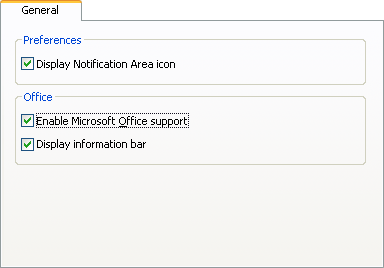
| Element | Description |
|---|---|
| Display Notification Area icon (checkbox) | Normally checked. Unless you are a Citrix user, uncheck to remove the Oracle IRM icon from the row of icons in the bottom right corner of the screen. When double-clicked, this icon opens the Oracle IRM Desktop options dialog. You can also open this dialog from the Windows Control Panel. Citrix users must not uncheck this box. |
| Enable Microsoft Office support (checkbox) | Normally checked. Uncheck to disable the integration of sealing options directly into your Microsoft Office applications. Unchecking this option disables the opening of sealed Microsoft Office files. |
| Display information bar (checkbox) | Normally checked. Uncheck to never show the Oracle IRM messages area in Microsoft Office documents. If checked, the information bar for a specific document can be closed by clicking the black cross on the right of the bar in that document. |
A.1.2 Desktop Sealing Tab
The desktop sealing feature integrates Oracle IRM sealing options into Windows Explorer:
-
Seal To, Reseal To and Unseal options are added to the File menu.
-
Options to create new sealed documents are added to the New submenu.
-
Oracle IRM information is added to the file properties available through Windows Explorer. If you select a file and open its Properties dialog, there is an Oracle IRM tab that shows, for example, which context the document is sealed to.
-
A pop-up description is displayed when you move your mouse pointer over the name of a sealed document (if Windows Explorer is configured to show such pop-ups).
Open the tab by selecting Desktop Sealing on the Oracle IRM Desktop Options dialog.
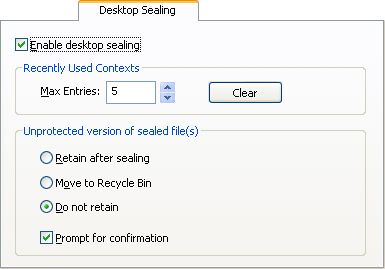
| Element | Description |
|---|---|
| Enable desktop sealing (checkbox) | Normally checked. Uncheck to disable desktop sealing. |
| Recently Used Contexts | Max Entries: Default value is 5. Enter a number (between 0 and 20) to specify how many recently used contexts are offered when you use the Seal To and Reseal To menu options. When you seal or reseal a file, you need to specify which context you want to seal to. The recently used context list makes it easier to complete this task. Use the Clear button to remove the current value. |
| Unprotected version of sealed file(s) | Use to determine what happens to the original files when sealed versions of them are created. The default is that such files are retained in an unprotected state.
Retain after sealing: The original files will not be removed after a sealed version has been created. The original files will be in an unprotected state. This is the default. Move to Recycle Bin: The original files will be moved to the Windows Recycle Bin after a sealed version has been created. The moved files can be recovered from the Windows Recycle Bin until the bin has been emptied. The file in the Windows Recycle Bin is in an unprotected state. If selected, the Prompt for confirmation checkbox becomes available and is unchecked. Do not retain: The original files will be removed after a sealed version has been created. This is a normal file system deletion, not a complete destruction of the file, so if you are concerned that this does not provide adequate security, you may want to consult your system administrator about further action. If selected, the Prompt for confirmation checkbox becomes available and is checked. Prompt for confirmation: Available if the Move to Recycle Bin option or the Do not retain option has been chosen. Select this checkbox if you want to see a prompt before an original file is deleted or moved after a sealed version has been created. The default status changes depending on which of the above options has been selected. |
A.1.3 Servers Tab
The Servers tab shows a list of the servers to which sealed documents are or can be synchronized. Most of the time the list is managed automatically. In rare circumstances, you might add or remove a server manually. For example, if you know that your account has been deleted on a server, you can use the settings to remove the server from the list.
Open the tab by selecting Servers on the Oracle IRM Desktop options dialog.

| Item | Description |
|---|---|
| [Oracle] IRM Servers | Lists the servers that are available for your sealed documents to be synchronized with.
Server: The address (URL) of the server. Update Rights: Normally checked. Any checked servers will be affected if you manually check in your rights. See Update Rights Tab. Uncheck a server if you do not want your rights to be checked in for that server. Clear Password: For the highlighted server, clears the stored username and password entered from this instance of Oracle IRM Desktop. You will need to clear the password if you have more than one user identity on the server and you wish to change from one identity to another (perhaps because the different identities have different document access rights associated with them). This is applicable only if you selected the Remember My Password checkbox on the Oracle IRM Server Credentials dialog. When you select the Clear Password button, you see a message that tells you either that the stored password has been cleared, or that no password is stored for the server. After the password has been cleared, you will be prompted to supply a username and password the next time that you need to contact the server, for example when opening a sealed document. Edit: Opens the Add Server Dialog, allowing you to change the URL of the item highlighted in the [Oracle] IRM Servers list. Remove: Removes the highlighted server from the list. There may be servers that cannot be removed, because of the way they have been configured. New: Opens the Add Server Dialog, through which you can add the URL of a server that you want added to the list. |
A.1.4 Update Rights Tab
The Update Rights tab lets you synchronize your rights on remote servers with your locally cached rights. This tab also lets you give up your locally cached rights so that the server can reissue them to you on another device.
Your locally cached rights allow you to keep working with sealed documents even when you are disconnected from the network and cannot contact the server. Typically, your cached rights allow you to keep using documents for several days before being required to contact the server.
Open the tab by selecting Update Rights on the Oracle IRM Desktop options dialog.
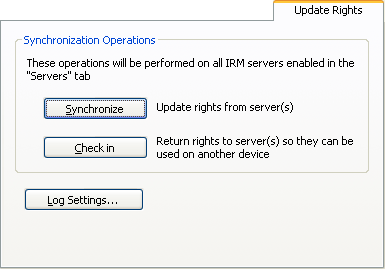
| Item | Description |
|---|---|
| Synchronize (button) | Updates the locally cached rights with those on the servers, where the Update Rights checkbox has been checked on the Servers tab. |
| Check in (button) | Gives up the locally cached rights for sealed documents managed by the servers whose Update Rights checkboxes have been checked on the Servers tab. |
| Log Settings (button) | Opens the Synchronization Log Configuration Dialog, through which you can select which synchronization message categories are written to the Windows event log. |
A.1.5 Search Tab
If enabled, searches of documents (in, for example, Windows Explorer) can find content in sealed documents that match the search criteria.
For the Microsoft Windows 2008, Windows Vista, and Windows 7 operating systems, the "advanced" indexed search facility must also be set up. If this is not done for these operating systems, the results of searches will exclude some file locations. For other operating systems, you do not need to set up the indexed search facility, although doing so will make searching more efficient.
Searches for content will attempt to match the search criteria in sealed documents as well as unsealed documents (presuming that you did not specify specific file types in which to search). The success of a search depends on whether you have the right to search the content of specific sealed documents in the folder. If the criteria are matched by content in a sealed document that you have the right to search, the sealed document is included in the search results.
You do not need to enable the search facility simply to search for the file names of sealed files.
Open the tab by selecting Search on the Oracle IRM Desktop Options dialog.

| Item | Description |
|---|---|
| Enable Search (checkbox) | Normally checked. Uncheck if you do not want sealed documents to be included in the results of searches. Checking this box will enable the logging and indexing features described below. |
| Search Messages | If searching is enabled, searches generate a log showing the history of successful and unsuccessful searches involving sealed documents. (Unsuccessful searches are typically a result of not having the right to search.)
Settings: Click to open the Search Log Configuration Dialog, through which you can choose whether the log is displayed, clear the contents of the log, view the log, and set the log location. |
| Indexed Search | You can configure the search component to enable the Microsoft Indexing Service to support sealed documents. Indexing can make searches more efficient, and is essential when searching within the Microsoft Windows 2008, Windows Vista, and Windows 7 operating systems.
Advanced: Click to open the Indexing Service Configuration Dialog, through which you can add details for the Oracle IRM Servers that will handle the indexing. |
A.1.6 Email Tab
The Oracle IRM Desktop email features integrate sealing options into the Microsoft Outlook or Lotus Notes mail clients. This enables you to create sealed messages and reply threads in those clients as easily as you can create regular email.
Users of other email clients can create and receive sealed email, but the option is not integrated into the mail client. Typically, you would select New from the File menu in Windows Explorer to create a new sealed message. You could then use the attachment functionality of any email client to send the sealed email message. Similarly, sealed email that you receive appears as an attachment that you open in the normal way.
Open the tab by selecting Email on the Oracle IRM Desktop options dialog.

| Item | Description |
|---|---|
| Enable sealed email integrations | Shows the supported mail clients and whether they are currently enabled for use with Oracle IRM Desktop. Mail clients not available on your computer are shown dimmed. Enabled mail clients are shown checked. To disable a mail client, uncheck it. |
| Settings (button) | Click to open the Sealed Email Options Dialog, through which you can:
|
A.1.7 About Tab
The About tab provides information about Oracle IRM Desktop, such as its version number and copyright information.
The tab also provides a Support Information link that you can use to collect information to assist support staff with problem diagnosis. If asked to provide further information about your Oracle IRM configuration, click the Support Information link and send the resultant file to your support representative.
Open the tab by selecting About on the Oracle IRM Desktop Options dialog. The About tab is also available from several other places, including the Oracle IRM Desktop Options dialog, the Oracle IRM Desktop Control Panel, and the Oracle IRM Desktop icon in the display notification area (system tray).
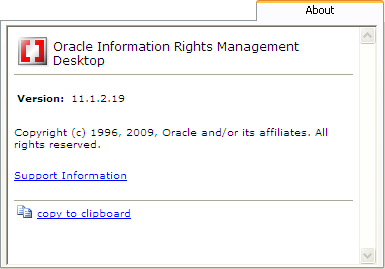
| Element | Description |
|---|---|
| Information area | Information about Oracle IRM Desktop. |
| Support Information (link) | Opens the Oracle IRM Desktop Support Information Dialog, through which information can be collected that is useful to support staff. |
| Copy to clipboard (link) | Copies the version and copyright information to the clipboard, from where it can be pasted into a text application. |
A.1.8 Add Server Dialog
Use the Add Server dialog to specify the URL of an Oracle IRM server.
Open the dialog by selecting the New or Edit buttons on the Servers tab of the Oracle IRM Options dialog, or on the Indexing Service Configuration dialog.

| Item | Description |
|---|---|
| Input box | Enter the URL of an Oracle IRM server.
For connection to an 11g server, the URL will be in the form For connection to a 10g server, the URL will be in the form |
| Validate (button) | Attempts to contact the server specified in the input box and validate the URL against the one configured on the Oracle IRM Server. This may not be the same URL entered here, and if successful the URL may be updated to match the one configured on the server. Success or failure is reported in a message dialog. If this option is not used, the URL is validated on clicking OK. |
A.1.9 Search Log Configuration Dialog
The search service writes messages to the Windows event log to report the status of the sealed document search.
Use the Search Log Configuration dialog to select which search message types are written to the Windows event log.
Open the dialog by selecting the Settings button on the Search tab of the Oracle IRM Desktop Options dialog.
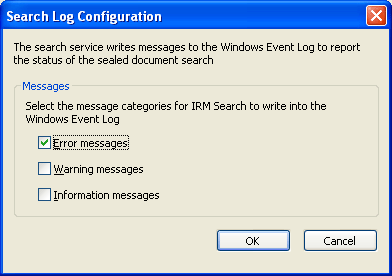
| Item | Description |
|---|---|
| Messages | For each message type that you want to appear in the Windows event log, make sure that its checkbox is checked. |
A.1.10 Synchronization Log Configuration Dialog
The synchronization manager writes messages to the Windows event log to report its status.
Use the Synchronization Log Configuration dialog to select which synchronization message categories are written to the Windows event log.
Open the dialog by selecting the Log Settings button on the Update Rights tab of the Oracle IRM Desktop Options dialog.
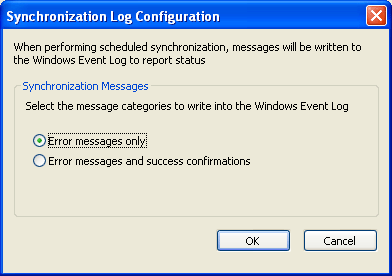
| Item | Description |
|---|---|
| Synchronization Messages | Select either Error messages only or Error messages and success confirmations. |
A.1.11 Indexing Service Configuration Dialog
You can configure the Oracle IRM Desktop search feature to use the Microsoft indexing service to support sealed documents. Indexing makes searches more efficient, and is essential for searching within the Microsoft Windows 2008, Windows Vista, and Windows 7 operating systems.
The ability to create an index is subject to the rights of the account that the indexing service uses when requesting the right to search documents. This could be a user account, or could be an account created on the server specifically for the indexing service. For example, if you are setting up an index on a file server rather than an end user system, you might want the indexing service to have its own account on the server so that it can create indexes even if it is not running under a user account. You would need to consult the server administrator to arrange for an account and the associated Search right. See About Rights. The configuration is machine-wide, and only accounts using basic (username/password) authentication can be used as Search accounts.
When the indexing service tries to index sealed documents, it refers to the server for search rights. If successful, the sealed documents are indexed. Note that, if the indexed folders contain sealed documents that are authorized by different servers, you need to add each of the servers to the list in this dialog.
Note:
Search indexes created as described in this section are not restricted to the account holding the Search right: they can be read by anyone with access to the host computer.Open the dialog by selecting the Advanced button on the Search tab of the Oracle IRM Desktop options dialog.
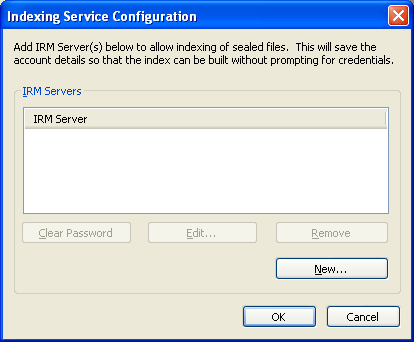
| Item | Description |
|---|---|
| [Oracle] IRM Server (list area) | This list is initially empty. When populated, the list shows the URL, authentication type, and username of servers that manage the rights for the sealed documents that you want to be included in the search index. To add a server to the list, click the New button. |
| Clear Password (button) | For the highlighted server, clears the stored username and password entered from this instance of Oracle IRM Desktop. You will need to clear the password if you have more than one user identity on the server and you wish to change from one identity to another (perhaps because the different identities have different search and document access rights associated with them). When you select the Clear Password button, you see a message that tells you either that the stored password has been cleared, or that no passwords are stored for the server. After the password has been cleared, you will be prompted to supply a username and password the next time that you perform a search or index operation that involves a sealed document. |
| New (button) | Click to open the Oracle IRM Server URL dialog. Through this you can enter the URL of a server that controls the rights for the sealed documents that you want to be able to index. |
| Edit (button) | Applies to the server currently highlighted in the list. Click to reopen the Oracle IRM Server URL dialog, through which you can change the details for the server. |
| Remove (button) | Click to remove the currently highlighted server from the list. |
A.2 Sealed Email Options Dialog
Open the dialog from the Email tab of the Oracle IRM Desktop Options dialog, by selecting at least one email client checkbox then selecting the Settings button.
The following tabs are used to set options for sealed email in Oracle IRM Desktop:
A.2.1 Signature Tab
Use to specify signature text to include in sealed email, and whether to use it for new sealed email and/or replies to existing sealed email.
Open the tab by selecting Signature on the Sealed Email Options dialog.
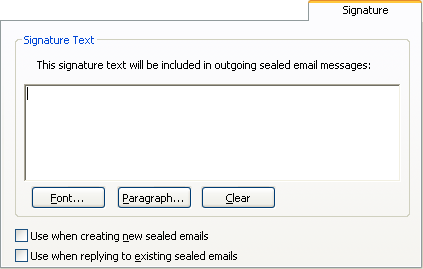
| Item | Description |
|---|---|
| Signature Text | Text box: Enter the text that will be used as the signature text.
Font: Applies to the highlighted text. Click to open the Font dialog, through which you can choose the font, style, size, effects, and script to be used for the signature text. Paragraph: Click to open the Paragraph dialog, through which you can choose the alignment of the current paragraph and whether it is bulleted. Clear: Click to clear the contents of the signature text box. |
| Use when creating new sealed emails (checkbox) | Normally unchecked. Check to use the signature when creating new sealed emails. |
| Use when replying to existing sealed emails (checkbox) | Normally unchecked. Check to use the signature when replying to existing sealed emails. |
A.2.2 Email Template Tab
Use to specify a custom template for sealed email. A standard template is provided as part of the Oracle IRM Desktop installation. A custom template is a Microsoft Word template that you or your administrator provides. You can select a Microsoft Word template even if you use rich text format for sealed email. A custom template can include Oracle IRM fields or other visual reminders that the email contains sensitive information. Templates are not used if you select plain text format for sealed email.
Open the tab by selecting Email Template on the Sealed Email Options dialog.
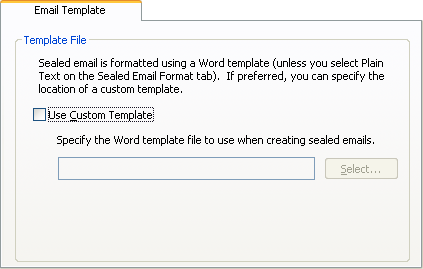
| Item | Description |
|---|---|
| Template File | Use Custom Template: Normally unchecked. Check if you have a custom template that you want to use instead of the standard template.
Microsoft Word template file box: This is available if you have checked the Use Custom Template box. Enter the location of the file that you want to use, or click the Select button to open a dialog through which you can find the required file. |
A.2.3 Email Body Tab
Use to specify text that will be placed in the body of an email to which sealed email is attached. All sealed email is transported as an attachment to a regular email. You could, for example, specify some text to say ""Please see the sealed attachment."
Open the tab by selecting Email Body on the Sealed Email Options dialog.
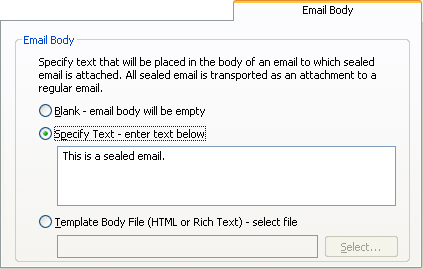
| Item | Description |
|---|---|
| Email Body | Blank: Select if you want the body of the accompanying unsealed email to be blank.
Specify Text: Normally selected. If selected, the accompanying text box is available for entering the text that you want in the email body. The default text is "This is a sealed email.". Overtype the current text with text of your own. Template Body File: Select if you want to use text in an HTML or rich text format file in the body of the email. If selected, the accompanying entry box is available. Enter the location of the file that you want to use, or click the Select button to open a dialog through which you can find the required file. |
A.2.4 Sealed Reply Settings Tab
Use to specify how you want sealed replies to appear.
Open the tab by selecting Sealed Reply Settings on the Sealed Email Options dialog.

| Item | Description |
|---|---|
| Message Font | Choose Font: Click to open the font dialog, through which you can select the font, style, size, effects, and script for the text in replies to sealed emails. The font options that you choose are applied to the text in the Sample box. |
| Indent original sealed mail message on reply (checkbox) | Normally checked. |
A.2.5 Sealed Email Format Tab
By default, your sealed email will be created in Microsoft Word format. If you prefer, you can specify that you want sealed email to be in plain text or rich text format. We recommend that you use the default format, although the other formats produce smaller email attachments. Using Microsoft Word format ensures backwards compatibility with previous versions of the Oracle IRM software, and provides better edit options, particularly for users whose rights require all changes to email to be tracked. The format you select for sealed email has no influence on the format of any sealed documents you attach to your sealed email.
Open the tab by selecting Sealed Email Format on the Sealed Email Options dialog.

| Item | Description |
|---|---|
| Format | Normally set to Microsoft Word. Select a format from the drop-down list. |
A.3 Oracle IRM Desktop Control Panel Dialog
The Oracle IRM Desktop Control Panel dialog provides access to a set of tabs that show information about the specific sealed document you are currently viewing, including your rights within the sealed document. It is accessed from the Oracle IRM icon in the toolbar of a sealed document, or by selecting the Control Panel link on any status page.
The Oracle IRM Desktop Control Panel dialog can display the following tabs, depending on what type of sealed document you currently have open:
A.3.1 Properties Tab
The Properties tab shows the properties of the sealed document you are currently viewing, such as when it was sealed and to which context.
The properties can help with diagnostics.
Open the tab by selecting Properties on the Oracle IRM Desktop Control Panel dialog, which you open by selecting the Oracle IRM icon in the toolbar of a sealed document, or by selecting the Control Panel link on any status page.
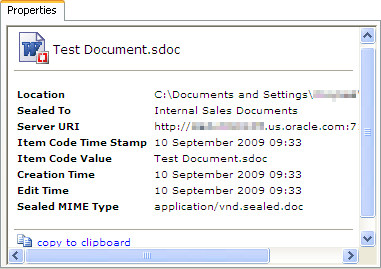
| Element | Description |
|---|---|
| Scrollable display area | Shows the properties of the sealed document you are currently viewing. |
| Copy to clipboard (link) | Copies the properties information to the clipboard, from where it can be pasted into a text application. |
A.3.2 Rights Tab
The Rights tab shows what rights you have for the current document, and when these rights have to be refreshed.
The list can vary depending on the type of sealed document you are viewing. For example, rights related to playing video files only appear when you access a video file.
Open the tab by selecting Rights on the Oracle IRM Desktop Control Panel dialog, which you open by selecting the Oracle IRM icon in the toolbar of a sealed document.

| Element | Description |
|---|---|
| Document information display area | Shows, in the following order:
|
| Feature (column) | Features equate to rights. The Features column lists the rights that have been allocated to the current user for the current sealed document.
Not all rights are listed. Where a main right includes a subsidiary right, and where both rights have been allocated to the current user, only the main right is shown. The following are examples of such compound rights:
If you have been allocated a subsidiary right, but not the main right, both rights are shown in the Features column, the subsidiary right with "Yes" against it, and the main right with "No" against it. |
| Allowed (column) | ""Yes" shows that the right has been allocated to the current user for the current sealed document.
"No" shows that the right has not been so allocated. |
| Trusted Destinations (display area) | You may have to scroll down to see this. If you have the Copy To right, a list of trusted destinations that you can reseal to and copy text to is shown here.
Note that if you have the Copy right, you will not have the Copy To right. This is because you do not need the Copy To right if you have the Copy right: with the Copy right, you can copy material from sealed documents to any other document, whether or not it is in a trusted destination. |
| Copy to clipboard (link) | You may have to scroll down to see this. Select to copy the rights information to the clipboard, from where it can be pasted into a text application. |
A.3.3 Account Tab
The Account tab identifies the server and user for a document sealed against a 10g version of Oracle IRM Server. The tab is shown only for documents sealed against a 10g version of Oracle IRM Server.
Open the tab by selecting Account on the Oracle IRM Desktop Control Panel dialog, which you open by selecting the Oracle IRM icon in the toolbar of a sealed document.
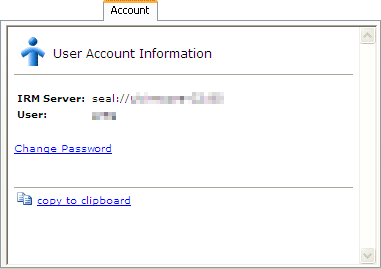
| Element | Description |
|---|---|
| Oracle IRM Server | Shows the 10g server against which the current document was sealed. |
| User | Shows the username for the current user of the sealed document. |
| Change Password (link) | Opens the Change Password Dialog (10g only), through which you can change the current user's password for accessing sealed documents on the current server. You will need to enter the old password before you are allowed to create a new password. This method of changing a password applies only to 10g servers. |
| Copy to clipboard (link) | Copies the user account information to the clipboard, from where it can be pasted into a text application. |
A.4 General Features
This section describes the dialogs that are available from various parts of the product. These include:
A.4.1 Oracle IRM Privacy Policy Dialog
This dialog will be displayed when you attempt to connect to an Oracle IRM Server for the first time.
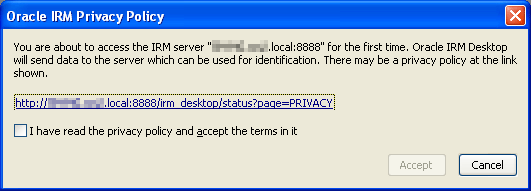
| Element | Description |
|---|---|
| Link | This may link to the privacy policy that applies to the use of the sealed document that is about to be opened. The policy and its accessibility from this link is controlled by the owner of the Oracle IRM Server instance. |
| I have read... (checkbox) | Initially unchecked. Check if you agree with the statement. If you do not agree, you will not be able to see the sealed document. To proceed, you must check the box even if the server owner has not provided a privacy policy. |
| Accept (button) | This becomes available if the "I have read..." box is checked. Select to open the sealed document. |
A.4.2 Select Context Dialog
For tasks that involve sealing or resealing documents, you will be prompted to select a context for that operation. In all cases, you will see the same context selection dialog.

| Element | Description |
|---|---|
| Context Selection information area and list box | Lists the contexts that you have the right to seal or reseal to. Usually provides a description of each context to help you choose the right one for the document or email you are currently sealing.
If the list is blank and you are trying to create a new sealed document, you must first connect to a server that holds context definitions that you have been given permissions to use. The easiest way to set up such a connection is to open a document that has been created by someone else and sealed to the same server and context to which you want to seal your new document. If this is not possible, you can connect to a server through the Servers tab on the Oracle IRM Desktop Options dialog. Do do this, you will need to know the URL of the server that you want to connect to. This will be in the following form:
You can obtain the exact URL from the administrator of the server. |
| Refresh Contexts (button) | Use to update the list of contexts, if you think it is incomplete. The list can be incomplete if your rights have changed recently such that your local cache is out of date. |
A.4.3 Change Item Code Dialog
This dialog will be displayed if you try to save a sealed document with an out of date item code and you have the right to update the item code (Set Item Code right). This may happen when you rename a sealed document, then edit it and save it.
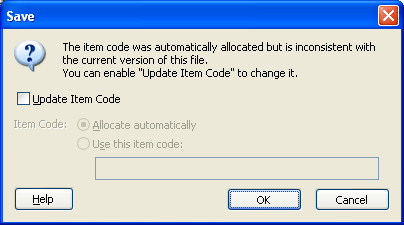
| Element | Description |
|---|---|
| Update Item Code (checkbox) | Normally unchecked. Check if you want to update the out of date item code. |
| Item Code | Allocate automatically: Select to have a new item code generated by Oracle IRM Desktop.
Use this item code: Select if you already have an item code that you want to allocate to this document. Selecting this option activates the accompanying input box, into which you can enter the new item code. |
A.4.4 Status Page Dialog
Open this dialog by selecting the Online Information icon on the Oracle IRM toolbar in a sealed document. This dialog opens automatically if sealed content cannot be displayed because of a problem.
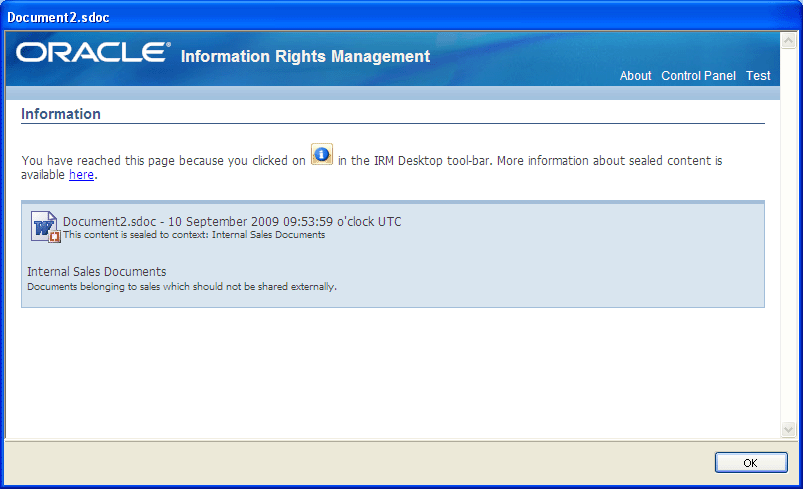
| Element | Description |
|---|---|
| Information area | Gives the reasons why this dialog has opened.
Rights held on another computer: This usually means that the sealed document cannot be viewed on the current computer until the rights have been checked in on another computer. Click Which Computer to identify the other computer. If the computer is identified as the one you are currently at, it is probable that the device ID has been changed since the rights information was initially requested: in this case, ask the server administrator to check in or reset the rights on the server. |
| About (link) | Links to a source of more information about Oracle IRM sealed content. |
| Control Panel (link) | Opens the Oracle IRM Desktop Control Panel. |
| Test (link) | Opens the Oracle IRM Server Connection Test Dialog, through which you can test your connection to servers. |
| Help (link) | Opens the Oracle IRM Desktop online help system. |
A.4.5 File Report Dialog
This dialog shows the results of a sealing operation when one or more files failed to seal.

| Element | Description |
|---|---|
| Files (list) | Lists the files that were not sealed during the recent sealing operation. |
| Error (display) | Shows the error related to the highlighted item in the Files list. Gives the reason why a file was not sealed. |
| Details (button) | Opens a dialog showing more details, if available, about why the file was not sealed. |
| Save to File (button) | Opens the Save As dialog to let you save the details in this report dialog as a text file. |
A.4.6 Sealed File Properties (Oracle IRM) Tab
Open the tab by right-clicking the filename of a sealed document in a file browser and selecting Properties, then selecting the Oracle IRM tab.

| Element | Description |
|---|---|
| Scrollable display area | Shows the properties of the document you are currently viewing. |
| Copy to clipboard (link) | Copies the properties information to the clipboard, from where it can be pasted into a text application. |
| Test (button) | Opens the Oracle IRM Server Connection Test Dialog, through which you can test your connection to servers. |
| Save Metadata (button) | Enables you to save a copy of the sealed file metadata in XML format. |
| Online Information (button) | Use this button to go to a web page where the content originator will provide more information about your account, your rights, and the current content. |
A.4.7 Oracle IRM Server Connection Test Dialog
This dialog is available from Oracle IRM Desktop status pages, and from the Test button on the Oracle IRM tab in the properties dialogs for sealed documents.
The Server Connection Test dialog can help to diagnose network problems and help your administrator to resolve them.

| Element | Description |
|---|---|
| Results | Test column: Identifies each test. Usually includes a simple connection test to the server, which requires no authentication of the user. Also usually includes an authenticated connection to the server, for which user credentials may have to be supplied through the Oracle IRM Server Credentials dialog.
Result column: Shows the result of the test (Pass, Fail, Canceled). Details button: Select to open a message box with more information about the tests, if there is any. Export button: Select to open a dialog through which you can save the test information as an HTML document. |
| Test (button) | Starts the test routine. |
A.4.8 Oracle IRM Desktop Support Information Dialog
This dialog is available from the Support Information link on About tabs.
Use this dialog to create a text file containing information about your installation and environment.
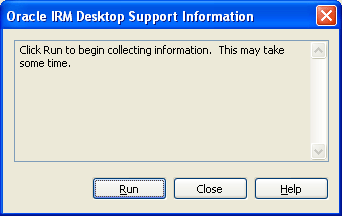
| Element | Description |
|---|---|
| Information display area | Initially contains advice and instructions. When the Run button is selected, this area shows the progress, and then gives the names and location of the text files containing the gathered support information. |
| Run (button) | Starts the gathering of support information. |
A.4.9 Change Password Dialog (10g only)
This dialog is available from the Change Password link on the Account tab of the Oracle IRM Desktop Control Panel. The Account tab is available only for some documents sealed against a 10g server.
Use this dialog to change the password used by the current user to access documents sealed on a 10g server.
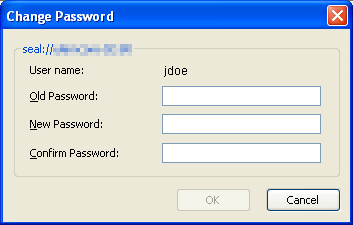
| Element | Description |
|---|---|
| Server name (display) | Shows the name of the server on which the current document is sealed, and for which the password change will apply. |
| User name (display) | Shows the name of the current user. |
| Old Password (text box) | Enter the current password for the user shown above. |
| New Password (text box) | Enter the new password to be used for the user shown above. |
| Confirm Password (text box) | Enter the new password again, in exactly the same way. |
A.4.10 Protected View Message Dialog
This dialog is shown if you attempt to open a sealed Microsoft Office file from within a Microsoft Office application that has Protected View turned on. (Protected View is a Microsoft Office 2010 feature.)
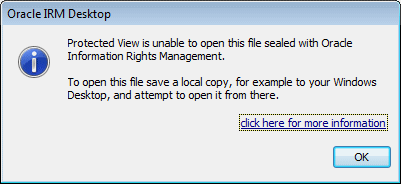
The use of sealed documents when Protected View is turned on is described in the following topics:
A.5 Oracle IRM Desktop Toolbars
This section describes the toolbars that are available when using sealed documents:
The location and appearance of the Oracle IRM Desktop toolbar differs slightly depending on whether you are viewing sealed documents in Internet Explorer or in Microsoft Office applications:
-
In Internet Explorer, when you are viewing sealed documents such as HTML and PDF, the Oracle IRM Desktop toolbar is shown at the top of the browser area.
-
In Microsoft Office applications, the Oracle IRM Desktop toolbar is shown in the toolbar area.
-
In Microsoft Office 2007 applications, the Oracle IRM Desktop toolbar is shown as a ribbon in the ribbons area.
A.5.1 Oracle IRM Desktop Toolbar in Internet Explorer
The toolbar contains the following buttons, from left to right:
![]()
| Button | Definition |
|---|---|
| Control Panel | Used to open the Oracle IRM Desktop Control Panel. |
| Save | Use this button to save changes to sealed documents while you are working on them, if you have the right to reseal. |
| Use this button to print sealed content, if you have the right to print. | |
| Synchronization and Check In | Use to open the the Update Rights Tab on the Oracle IRM Desktop Options dialog. You can use this tab to update your rights from Oracle IRM Server, or to check in your rights so that they can be used from another device. |
| Online Information | Use this button to go to a web page where the content originator will provide more information about your account, your rights, and the current content. |
A.5.2 Oracle IRM Desktop Toolbar in Microsoft Office
The toolbar contains the following buttons, from left to right:
![]()
| Button | Definition |
|---|---|
| Control Panel | Used to open the Oracle IRM Desktop Control Panel. |
| Synchronization and Check In | Use to open the the Update Rights Tab on the Oracle IRM Desktop Options dialog. You can use this tab to update your rights from Oracle IRM Server, or to check in your rights so that they can be used from another device. |
| New Sealed | Use this button to create a new sealed document or a new sealed document from a sealed template. |
| Open Sealed | Use this button to open a dialog through which you can open existing sealed documents. |
| Save as Sealed | Use this button to create a sealed version of the current unsealed document. |
| Online Information | Use this button to go to a web page where the content originator will provide more information about your account, your rights, and the current content. |
You can drag the Oracle IRM Desktop toolbar to a different location within the toolbar area, just as for any other toolbar in Microsoft Office.
Beneath the toolbar area in Microsoft Office is the Oracle IRM information bar (if the option to display it has been selected in the Oracle IRM Desktop Options dialog).
The information bar usually shows which context the document is sealed to.
A.5.3 Oracle IRM Desktop Toolbar in Microsoft Office 2007 and Microsoft Office 2010
The toolbar contains the following buttons:

| Button | Definition |
|---|---|
| Control Panel | Used to open the Oracle IRM Desktop Control Panel. |
| Online Information | Use this button to go to a web page where the content originator will provide more information about your account, your rights, and the current content. |
| New Sealed | Use this button to create a new sealed document or a new sealed document from a sealed template. |
| Open Sealed | Use this button to open a dialog through which you can open existing sealed documents. |
| Save as Sealed | Use this button to create a sealed version of the current unsealed document. |
| Synchronization and Check In | Use to open the the Update Rights Tab on the Oracle IRM Desktop Options dialog. You can use this tab to update your rights from Oracle IRM Server, or to check in your rights so that they can be used from another device. |